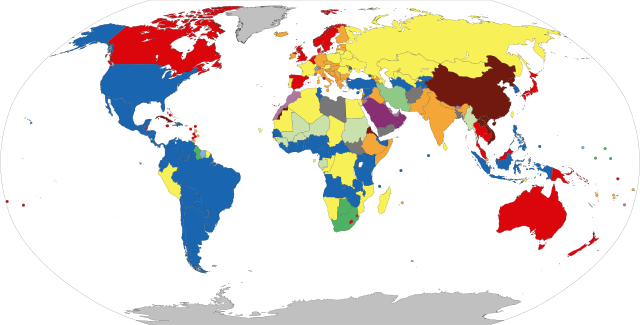অর্ধ-রাষ্ট্রপতিশাসিত শাসনব্যবস্থা
সরকার ব্যবস্থা উইকিপিডিয়া থেকে, বিনামূল্যে একটি বিশ্বকোষ
একটি অর্ধ-রাষ্ট্রপতিশাসিত শাসনব্যবস্থা বা দ্বৈত-নির্বাহী শাসনব্যবস্থা বলতে এমন এক ধরনের সরকার ব্যবস্থাকে বোঝায়, যাতে একজন রাষ্ট্রপতি একজন প্রধানমন্ত্রী ও তাঁর মন্ত্রীসভার সাথে সহাবস্থান করেন এবং শেষোক্ত দুইটি রাষ্ট্রের আইনসভার কাছে জবাবদিহি করেন। একটি সংসদীয় প্রজাতন্ত্রের সাথে এই সরকার ব্যবস্থাটির পার্থক্য হল এই যে এটিতে জনগণের ভোটে নির্বাচিত একটি রাষ্ট্রপ্রধান থাকেন যিনি কেবলমাত্র একজন আনুষ্ঠানিক প্রতিমা নন। অন্যদিকে একটি রাষ্ট্রপতিশাসিত সরকার ব্যবস্থা থেকে এটির পার্থক্য হল এই যে যদিও মন্ত্রীসভা রাষ্ট্রপতি দ্বারা পদপ্রাপ্ত হয়, তার পরেও সেটি আইনসভার কাছে জবাবদিহি করে, রাষ্ট্রপতির কাছে নয়; আইনসভা একটি অনাস্থা প্রস্তাবের মাধ্যমে জোরপূর্বক মন্ত্রীসভাকে পদত্যাগে বাধ্য করতে পারে।[১][২][৩][৪]

বিশ্বের রাষ্ট্রগুলোকে সরকার ব্যবস্থা অনুযায়ী দেখানো হয়েছে১
|
২ সাংবিধানিকভাবে বহুদলীয় প্রজাতন্ত্র হিসেবে বিবেচিত বেশ কয়েকটি রাষ্ট্রকে অন্যান্য রাষ্ট্র কর্তৃত্ববাদী রাষ্ট্র হিসাবে চিহ্নিত করে থাকে। এই মানচিত্রটি বাস্তবত (কার্যত) গণতন্ত্রের মাত্রা অনুযায়ী নয় বরং সাংবিধানিক (আইনত) অবস্থার ভিত্তিতে তৈরি।
জার্মানির দুই বিশ্বযুদ্ধ মধ্যবর্তী ভাইমার প্রজাতন্ত্র (১৯১১-১৯৩৩) ও ১৯১৯ থেকে ২০০০ সাল পর্যন্ত ফিনল্যান্ডকে অর্ধ-রাষ্ট্রপতিশাসিত সরকার ব্যবস্থার দুইটি প্রথম দিকের উদাহরণ হিসেবে গণ্য করা যায়। কিন্তু "অর্ধ-রাষ্ট্রপতিশাসিত" পরিভাষাটি সর্বপ্রথম ব্যবহার করেন ফরাসি সাংবাদিক উ্যবের ব্যোভ-মেরি (Hubert Beuve-Méry), ১৯৫৯ সালে প্রকাশিত একটি নিবন্ধে।[৫] এরপর ১৯৭৮ সালে ফরাসি রাষ্ট্রবিজ্ঞানী মোরিস দ্যুভের্জে (Maurice Duverger) রচিত একটি গ্রন্থ পরিভাষাটিকে আরও জনপ্রিয় করে তোলে।[৬] উভয়েই ১৯৫৮ সালে প্রতিষ্ঠিত ও অদ্যাবধি (২০২২) বিদ্যমান ফ্রান্সের ৫ম প্রজাতন্ত্রটিকে বর্ণনা করতে গিয়ে এই পরিভাষাটি ব্যবহার করেন।[১][২][৩][৪]
সংজ্ঞা
মোরিস দ্যুভের্জে-র আদি সংজ্ঞা অনুযায়ী একটি অর্ধ-রাষ্ট্রপতিশাসিত সরকার ব্যবস্থাতে রাষ্ট্রপতিকে অবশ্যই জনগণের ভোটে নির্বাচিত হতে হবে, তাঁর তাৎপর্যপূর্ণ ক্ষমতা থাকবে এবং তিনি নির্দিষ্ট মেয়াদের জন্য কার্যনির্বাহ করবেন।[৭] আধুনিক সংজ্ঞাগুলিতে বলা হয় যে এই ব্যবস্থায় রাষ্ট্রপ্রধানকে নির্বাচিত হতে হবে, এবং স্বতন্ত্র ও সংসদীয় আস্থার উপর নির্ভরশীল একজন প্রধানমন্ত্রী নির্বাহী বিভাগকে নেতৃত্ব দেবেন।[৭]
আরও দেখুন
- সরকার ব্যবস্থা অনুযায়ী দেশের তালিকা
- সংসদীয় ব্যবস্থা
- রাষ্ট্রপতিশাসিত ব্যবস্থা
- অর্ধ-সংসদীয় ব্যবস্থা
টীকা
তথ্যসূত্র
বহিঃসংযোগ
Wikiwand - on
Seamless Wikipedia browsing. On steroids.
